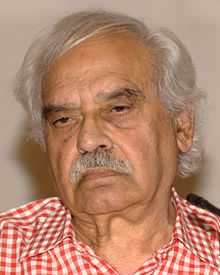Rasheed Araeen

Rasheed Araeen (born 1935) is a London-based conceptual artist, sculptor, painter, writer, and curator. He graduated in civil engineering from the University of Karachi in 1962, and has been working as a visual artist since his arrival in London from Pakistan in 1964.
Art career
He began working as an artist without any formal training, producing sculptures influenced by Minimalism and by his engineering experience. In 1972 he joined the Black Panther Movement. Six years later he founded and began editing the journal Black Phoenix, which in 1989, was transformed into Third Text, one of the most important journals dealing with art, the Third World, Postcolonialism, and ethnicity. He is one of the pivotal figures in establishing a black voice in the British arts through his activities as a publisher, writer, and artist. His work demonstrates a concern with the problems of establishing an identity for the third-world artists.
He belongs to an early generation of non-Western artists to live in the West. His artistic activity has been complemented since 1987 by the groundbreaking publication of Third Text. Third World Perspectives on Contemporary Art and Culture. In the first decade of its publication, the main aim was to reveal "the institutional closures of the art world and the artists they included, the second began the inquiry into the emergent phenomenon first signaled by the notorious show Magiciens de la terre of the assimilation of the exotic other into the new world art," as Sean Cubitt summarized the goals in the Third Text Reader in 2002. In 1999 Araeen spoke about his own journal Third Text as an attempt to "demolish the boundaries that separate art and art criticism". He believed that writing was tantamount to raising his voice against the hegemonic discourse of the art world. This discourse had confined him to an ethnic stereotype that prevented him from becoming an artist in his own right.
Rasheed Araeen has been among the first cultural practitioners to voice since the early 1970s the need of artists of African, Latin American and Asian origins to be represented in British cultural institutions. His approach allowed him to shape his ideas through a number of different media. He, in fact, curated exhibitions; initiated and published a number of journals (among which, besides the aforementioned Third Text, there is the 1978 Black Phoenix); produced art installations and community-based artistic projects.
In 2001 he was invited by the Kunsthaus Bregenz in Austria to publish his institutional critique of the present art museum in the publication "The Museum as Arena". Araeen published the outcome of his private correspondence with the Ikon Gallery in Birmingham, which had asked him to join an exhibition in 1980 (this correspondence was also published in Rasheed Araeen, Making Myself Visible). His proposal was declined when the other ten artists refused to show their work alongside his. Their opposition not only manifested cultural conflicts, but was also meant to defend the purity of the gallery space where Araeen had proposed to perform the slaughter and consumption of a goat (according to a Muslim ritual). Along with the actual performance, he had announced that he would display and tear up "the pages of a contemporary art history book". Thus, the offence directed against the aesthetics of the art gallery was complemented with a rejection of the official story of modernist art and avantgarde history. Araeen participated in the 9th Gwangju Biennale (2012).[1]
Works
From Third Text, Kala Press [incorporating Black Phoenix], London 1987:
- Conversation with Aubrey Williams, Third Text #2, Winter 1987
- From Primitivism to Ethnic Arts / & / Why Third Text?, Third Text #1, Autumn 1987
- Gravity and [Dis] Grace, Third Text #22, Spring 1993
- Our Bauhaus Others' Mudhouse [the "magiciens de la terre" issue], Third Text #6, Spring 1989
- A Discussion with other artists and curators of Manifesta 1, in Witte de With, Cahier #5, Witte de With center for contemporary art, Rotterdam 1.
References
- Making Myself Visible (London: Kala Press, 1984)
- From Modernism to Postmodernism: Rasheed Araeen: a Restrospective, exh. cat., essays by P. Bickers, J. Roberts, and D. Phillipi (Birmingham: Ikon Gal., 1987)
- From Two Worlds (London: Whitechapel Art Gallery, 1986)
- Global Visions: Towards a New Internationalism in the Visual Arts (London: Kala Press, 1994)
- Rasheed Araeen, exh. cat., essay by P. Overy (London: S. London A. G., 1994)
External links
| Wikimedia Commons has media related to Rasheed Araeen. |
- Third Text Online
- Tate Gallery Web Site
- http://www.undo.net/Pinto/Eng/earaeen.htm
- Work's list of Araeen
|